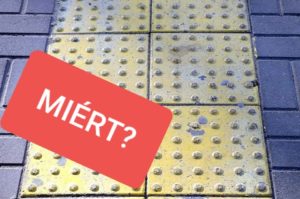nother piece of our WHY? campaign:
Have you ever seen “something” during your city walks, in public institutions or somewhere else, that stands out on the floor and has a different colour? So this is the blind guide lane, that makes access easier for blind people.
The right blind guide lanes are higher than the pavement therefore can be perceived with the white stick and if you step on it. They are marked with distinctive colour for those who can still see a little bit.
Usually they are made for two purposes:
- Indicating direction for those who can’t see in front of them at all, especially the absolutely blind people. The guide lane is followable, provides security when approaching frequently visited objects (e.g. crosswalk, toilets, junctions, tracks at the train station).
- As warning signals, most commonly at junctions and at the end of the sidewalk. This is a well perceivable dotted surface, also with feet and this is even a little higher. Near crosswalk and stairs it can save lives.
Blind guide lanes are very useful but only if they have been made with expertise. Unfortunately there are many negative examples. Sometimes the lane has no end, it disappears after a while or there is nothing to follow after the starting direction. It also happens that the lane brings the person in the wrong direction: to the building’s walls, shop-window or drive-way.
There are very few blind guide lanes in Hungary, they can be found only at the busiest locations of cities.
Thank you to our members Róbert Rauch of sharing experience!
(MIÉRT? = WHY?) 
